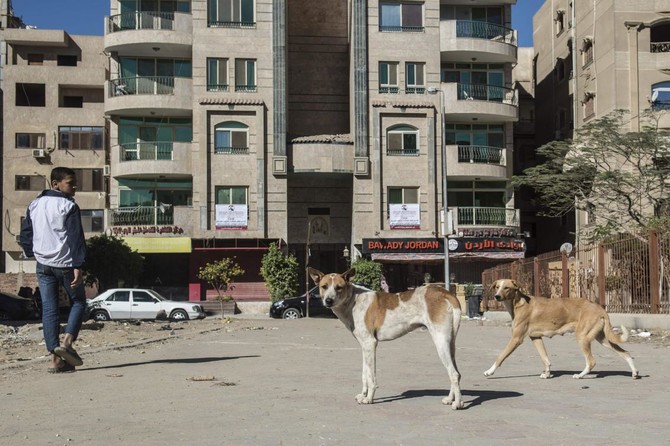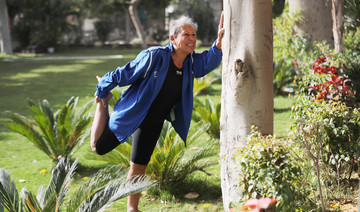CAIRO: Alaa Hilal was out shopping in Cairo when she was attacked by a stray dog in broad daylight — an increasing problem of daily life in Egypt which is stirring debate.
“I got out of my car and saw an exceptionally large street dog,” the 38-year-old housewife told AFP at her home, northeast of Cairo.
“He approached me and bit me without barking or doing anything else,” said Hilal, adding that she had been injured in the thigh.
An overpopulated mega-city of more than 20 million people, Cairo is already plagued by monster traffic jams, widespread waste problems and rampant pollution. Packs of stray dogs are only adding to the city’s challenges.
Complaints about dog attacks, exposure to rabies and in some cases even deaths over the years have triggered calls for the animals to be brought under control.
Commonly referred to as “baladi dogs,” strays are widely viewed as unsanitary and dirty. They are typically seen running around the streets and scavenging garbage for food.
According to the agriculture ministry, there were around 400,000 cases of dog bites in 2017, up from 300,000 in 2014.
And 231 people died over the past four years from the wounds they received, mainly as a result of rabies.
A bite from a dog carrying the rabies virus can be fatal within 24 hours as it damages the human’s nervous system, said Shehab Abdel-Hamid, the head of Egypt’s society for the prevention of cruelty to animals (SPCA).
Hilal, who had never feared dogs having had several pets when growing up, was rushed to a nearby hospital only to discover that she was the ninth person to be bitten by the same dog.
“Due to the trauma caused by this incident, I became worried and I no longer want to be in the same place with them,” she said.
There are no official data on the numbers of stray dogs, but activists say they are running loose in their millions.
A survey by the SPCA showed that the number of stray dogs “may reach up to more than 15 million,” Abdel-Hamid said.
And though street dogs appear to fear the most crowded areas, they can be loud and aggressive in poorly lit and rubbish-strewn suburbs.
In November, a video widely circulated on social media showed a car hitting a teenager who was being chased by two stray dogs.
“Garbage is the main reason behind the stray dogs’ crisis in Egypt,” said Abdel-Hamid, highlighting how the problem was exacerbated when the rubbish men stopped working during the 2011 uprising.
The SPCA, however, lacks resources. Its headquarters in downtown Cairo was looted during the uprising and has not been renovated since, Abdel-Hamid added.
And Egyptian authorities say they can only intervene on a case by case basis.
“We do not go around the streets looking for dogs to kill them,” said the agriculture ministry spokesman Hamed Abdel-Dayem. “We only take measures following complaints.”
He didn’t specify what measures are taken to bring the stray dog population under control.
But animal rights advocates often lambast the government, accusing it of mass culls.
In 2017, authorities killed more than 17,000 stray dogs following multiple complaints of dog “disturbances” and “biting” in Beni Sueif, south of Cairo, according to an August report by the governorate’s veterinary directorate.
The Red Sea governor even offered a 100 Egyptian pounds ($5.58) award to those who capture and hand over at least five strays.
Animal rights defenders also accuse the government of killing dogs using a drug, known as “strychnine,” a chemical substance listed as “unacceptable on animal welfare grounds” for euthanasia by the World Organization for Animal Health.
But Abdel-Dayem denied that the government imported banned substances.
“Is it logical that we (the ministry) allow internationally prohibited substances to enter the country?” he told AFP when asked about the strychnine claim.
Animal rights advocates have sought to offer solutions, actively removing dogs from the streets and giving them homes.
Ahmed Al-Shorbagi, 35, opened two dog shelters in a desert area west of Cairo, near the famed Giza pyramids.
The buildings with sheer concrete walls have kept more than 250 dogs safe for the past three years. Shorbagi contributes 40 percent to the funding of the shelters while the rest comes from donations.
“At first I followed the animal rescue pages on Facebook,” Shorbagi told AFP, rubbing one dog’s belly as she wagged her tail in joy.
“I saved a dog that I called ‘Hope’ and when I opened the shelter, I named it after her.”
Shorbagi believes the solution lies in dog sterilization programs, providing rabies vaccinations and removing the garbage.
“Instead of the government paying millions of dollars to import poison, it should consider sterilization,” he said.
“We, as associations, proposed to the ministry of agriculture to solve the problem but it refused.”
The ministry’s spokesman denied however refusing to cooperate with private entities and hailed their work to help resolve the crisis.
In Egypt, stray dogs pose growing urban challenge
In Egypt, stray dogs pose growing urban challenge

- Cairo is already plagued by monster traffic jams, widespread waste problems and rampant pollution
- According to the agriculture ministry, there were around 400,000 cases of dog bites in 2017, up from 300,000 in 2014
A 98-year-old in Ukraine walked miles to safety from Russians, with slippers and a cane

- Describing her journey, the nonagenarian said she had fallen twice and was forced to stop to rest at some points, even sleeping along the way before waking up and continuing her journey
KYIV, Ukraine: A 98-year-old woman in Ukraine who escaped Russian-occupied territory by walking almost 10 kilometers (6 miles) alone, wearing a pair of slippers and supported by a cane has been reunited with her family days after they were separated while fleeing to safety.
Lidia Stepanivna Lomikovska and her family decided to leave the frontline town of Ocheretyne, in the eastern Donetsk region, last week after Russian troops entered it and fighting intensified.
Russians have been advancing in the area, pounding Kyiv’s depleted, ammunition-deprived forces with artillery, drones and bombs.
“I woke up surrounded by shooting all around — so scary,” Lomikovska said in a video interview posted by the National Police of Donetsk region.
In the chaos of the departure, Lomikovska became separated from her son and two daughters-in-law, including one, Olha Lomikovska, injured by shrapnel days earlier. The younger family members took to back routes, but Lydia wanted to stay on the main road.
With a cane in one hand and steadying herself using a splintered piece of wood in the other, the pensioner walked all day without food and water to reach Ukrainian lines.
Describing her journey, the nonagenarian said she had fallen twice and was forced to stop to rest at some points, even sleeping along the way before waking up and continuing her journey.
“Once I lost balance and fell into weeds. I fell asleep … a little, and continued walking. And then, for the second time, again, I fell. But then I got up and thought to myself: “I need to keep walking, bit by bit,’” Lomikovska said.
Pavlo Diachenko, acting spokesman for the National Police of Ukraine in the Donetsk region, said Lomikovska was saved when Ukrainian soldiers spotted her walking along the road in the evening. They handed her over to the “White Angels,” a police group that evacuates citizens living on the front line, who then took her to a shelter for evacuees and contacted her relatives.
“I survived that war,’ she said referring to World War II. “I had to go through this war too, and in the end, I am left with nothing.
“That war wasn’t like this one. I saw that war. Not a single house burned down. But now – everything is on fire,” she said to her rescuer.
In the latest twist to the story, the chief executive of one of Ukraine’s largest banks announced on his Telegram channel Tuesday that the bank would purchase a house for the pensioner.
“Monobank will buy Lydia Stepanivna a house and she will surely live in it until the moment when this abomination disappears from our land,” Oleh Horokhovskyi said.
Amazon Purr-rime: Cat accidentally shipped to online retailer

- Galena was found safe by a warehouse worker at an Amazon center after vanishing from her home in Utah
LOS ANGELES: A curious cat that sneaked into an open box was shipped across the United States to an Amazon warehouse after its unknowing owners sealed it inside.
Carrie Clark’s pet, Galena, vanished from her Utah home on April 10, sparking a furious search that involved plastering “missing” posters around the neighborhood.
But a week later, a vet hundreds of miles (kilometers) away in Los Angeles got in touch to say the cat had been discovered in a box — alongside several pairs of boots — by a warehouse worker at an Amazon center.
“I ran to tell my husband that Galena was found and we broke down upon realizing that she must have jumped into an oversized box that we shipped out the previous Wednesday,” Clark told KSL TV in Salt Lake City.
“The box was a ‘try before you buy,’ and filled with steel-toed work boots.”
Clark and her husband jetted to Los Angeles, where they discovered Amazon employee Brandy Hunter had rescued Galena — a little hungry and thirsty after six days in a cardboard box, but otherwise unharmed.
“I could tell she belonged to someone by the way she was behaving,” said Hunter, according to Amazon.
“I took her home that night and went to the vet the next day to have her checked for a microchip, and the rest is history.”
What did people eat before agriculture? New study offers insight

- Analysis of forms — or isotopes — of elements including carbon, nitrogen, zinc, sulfur and strontium in these remains indicated the type and amount of plants and meat they ate
WASHINGTON: The advent of agriculture roughly 11,500 years ago in the Middle East was a milestone for humankind — a revolution in diet and lifestyle that moved beyond the way hunter-gatherers had existed since Homo sapiens arose more than 300,000 years ago in Africa.
While the scarcity of well-preserved human remains from the period preceding this turning point has made the diet of pre-agricultural people a bit of a mystery, new research is now providing insight into this question. Scientists reconstructed the dietary practices of one such culture from North Africa, surprisingly documenting a heavily plant-based diet.
The researchers examined chemical signatures in bones and teeth from the remains of seven people, as well as various isolated teeth, from about 15,000 years ago found in a cave outside the village of Taforalt in northeastern Morocco. The people were part of what is called the Iberomaurusian culture.
Analysis of forms — or isotopes — of elements including carbon, nitrogen, zinc, sulfur and strontium in these remains indicated the type and amount of plants and meat they ate. Found at the site were remains from different edible wild plants including sweet acorns, pine nuts, pistachio, oats and legumes called pulses. The main prey, based on bones discovered at the cave, was a species called Barbary sheep.
“The prevailing notion has been that hunter-gatherers’ diets were primarily composed of animal proteins. However, the evidence from Taforalt demonstrates that plants constituted a big part of the hunter-gatherers’ menu,” said Zineb Moubtahij, a doctoral student in archaeology at the Max Planck Institute for Evolutionary Anthropology in Germany and lead author of the study published on Monday in the journal Nature Ecology & Evolution.
“It is important as it suggests that possibly several populations in the world already started to include substantial amount of plants in their diet” in the period before agriculture was developed, added archeogeochemist and study co-author Klervia Jaouen of the French research agency CNRS.
The Iberomaurusians were hunter-gatherers who inhabited parts of Morocco and Libya from around 25,000 to 11,000 years ago. Evidence indicates the cave served as a living space and burial site.
These people used the cave for significant portions of each year, suggesting a lifestyle more sedentary than simply roaming the landscape searching for resources, the researchers said. They exploited wild plants that ripened at different seasons of the year, while their dental cavities illustrated a reliance on starchy botanical species.
Edible plants may have been stored by the hunter-gatherers year-round to guard against seasonal shortages of prey and ensure a regular food supply, the researchers said.
These people ate only wild plants, the researchers found. The Iberomaurusians never developed agriculture, which came relatively late to North Africa.
“Interestingly, our findings showed minimal evidence of seafood or freshwater food consumption among these ancient groups. Additionally, it seems that these humans may have introduced wild plants into the diets of their infants at an earlier stage than previously believed,” Moubtahij said.
“Specifically, we focused on the transition from breastfeeding to solid foods in infants. Breast milk has a unique isotopic signature, distinct from the isotopic composition of solid foods typically consumed by adults.”
Two infants were among the seven people whose remains were studied. By comparing the chemical composition of an infant’s tooth, formed during the breastfeeding period, with the composition of bone tissue, which reflects the diet shortly before death, the researchers discerned changes in the baby’s diet over time. The evidence indicated the introduction of solid foods at around the age of 12 months, with babies weaned earlier than expected for a pre-agricultural society.
North Africa is a key region for studying Homo sapiens evolution and dispersal out of Africa.
“Understanding why some hunter-gatherer groups transitioned to agriculture while others did not can provide valuable insights into the drivers of agricultural innovation and the factors that influenced human societies’ decisions to adopt new subsistence strategies,” Moubtahij said.
Palestinian prisoner in Israel wins top fiction prize

- The mask in the novel’s title refers to the blue identity card that Nur, an archaeologist living in a refugee camp in Ramallah, finds in the pocket of an old coat belonging to an Israeli
ABU DHABI: Palestinian writer Basim Khandaqji, jailed 20 years ago in Israel, won a prestigious prize for Arabic fiction on Sunday for his novel “A Mask, the Color of the Sky.”
The award of the 2024 International Prize for Arabic Fiction was announced at a ceremony in Abu Dhabi.
The prize was accepted on Khandaqji’s behalf by Rana Idriss, owner of Dar Al-Adab, the book’s Lebanon-based publisher.
Khandaqji was born in the Israeli-occupied West Bank city of Nablus in 1983, and wrote short stories until his arrest in 2004 at the age of 21.
He was convicted and jailed on charges relating to a deadly bombing in Tel Aviv, and completed his university education from inside jail via the Internet.
The mask in the novel’s title refers to the blue identity card that Nur, an archaeologist living in a refugee camp in Ramallah, finds in the pocket of an old coat belonging to an Israeli.
Khandaqji’s book was chosen from 133 works submitted to the competition.
Nabil Suleiman, who chaired the jury, said the novel “dissects a complex, bitter reality of family fragmentation, displacement, genocide, and racism.”
Since being jailed Khandaqji has written poetry collections including “Rituals of the First Time” and “The Breath of a Nocturnal Poem.”
He has also written three earlier novels.
Mexican doctor claims victory in $28 Cartier earrings battle

MEXICO CITY: A Mexican man has claimed a victory over French luxury brand Cartier, saying an error allowed him to buy two pairs of earrings for $28 that were supposed to cost nearly $28,000.
After a four-month struggle, doctor Rogelio Villarreal said he had finally received the jewelry, which he accused the company of refusing to deliver after his online purchase in December.
According to Villarreal, he came across the low-priced earrings while browsing Instagram.
“I swear I broke out in a cold sweat,” he wrote on the social media platform X.
Cartier declined to recognize the purchase and offered Villarreal a refund, as well as a bottle of champagne and a passport holder as compensation, according to a company letter shared by the doctor.
But Villarreal refused and decided to take the case to Mexico’s consumer protection agency, which ruled in favor of the doctor.
Cartier accepted the decision, Villarreal announced.
“War is over. Cartier is complying,” he wrote.



















